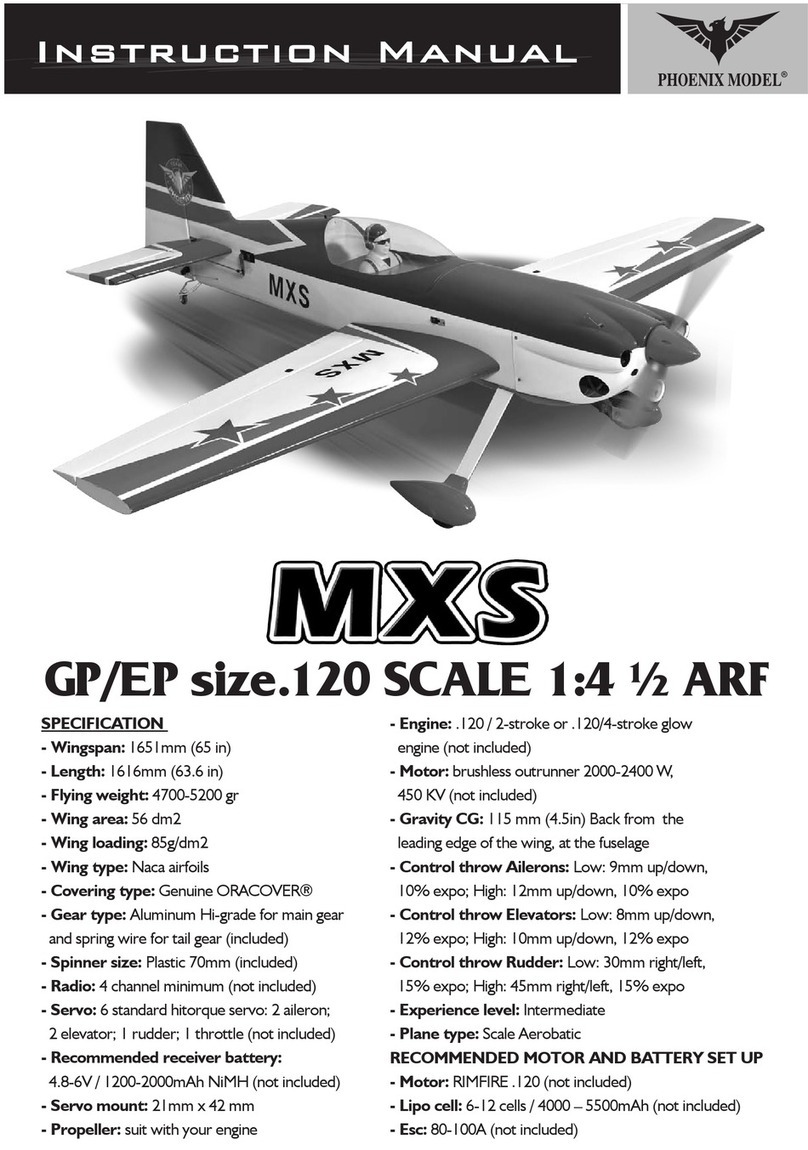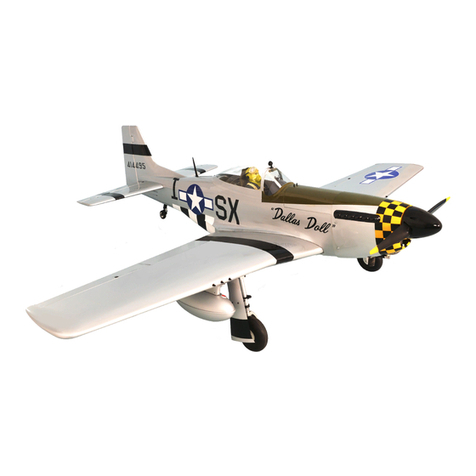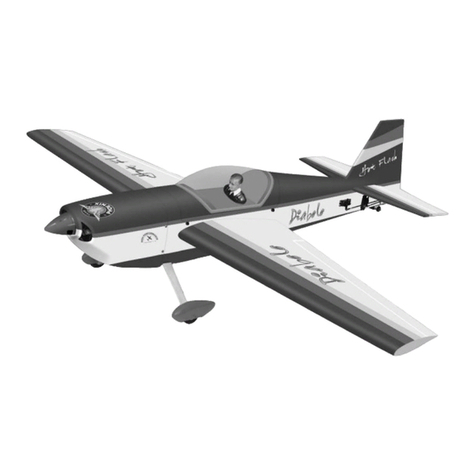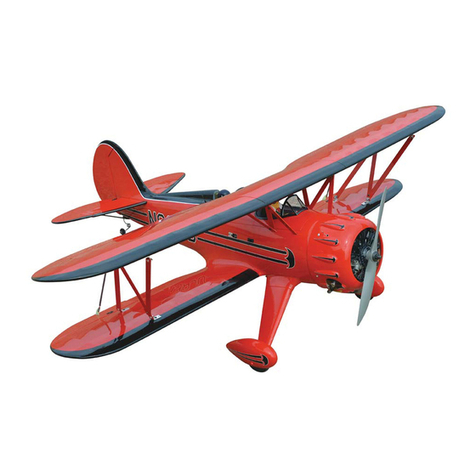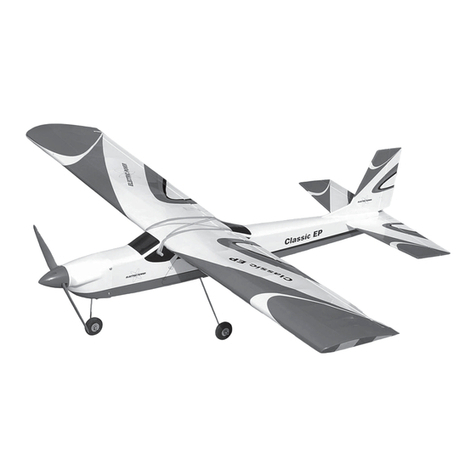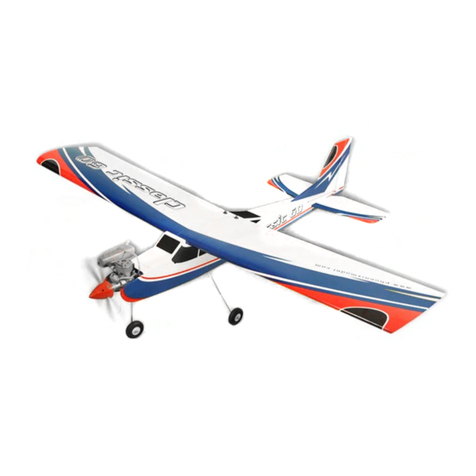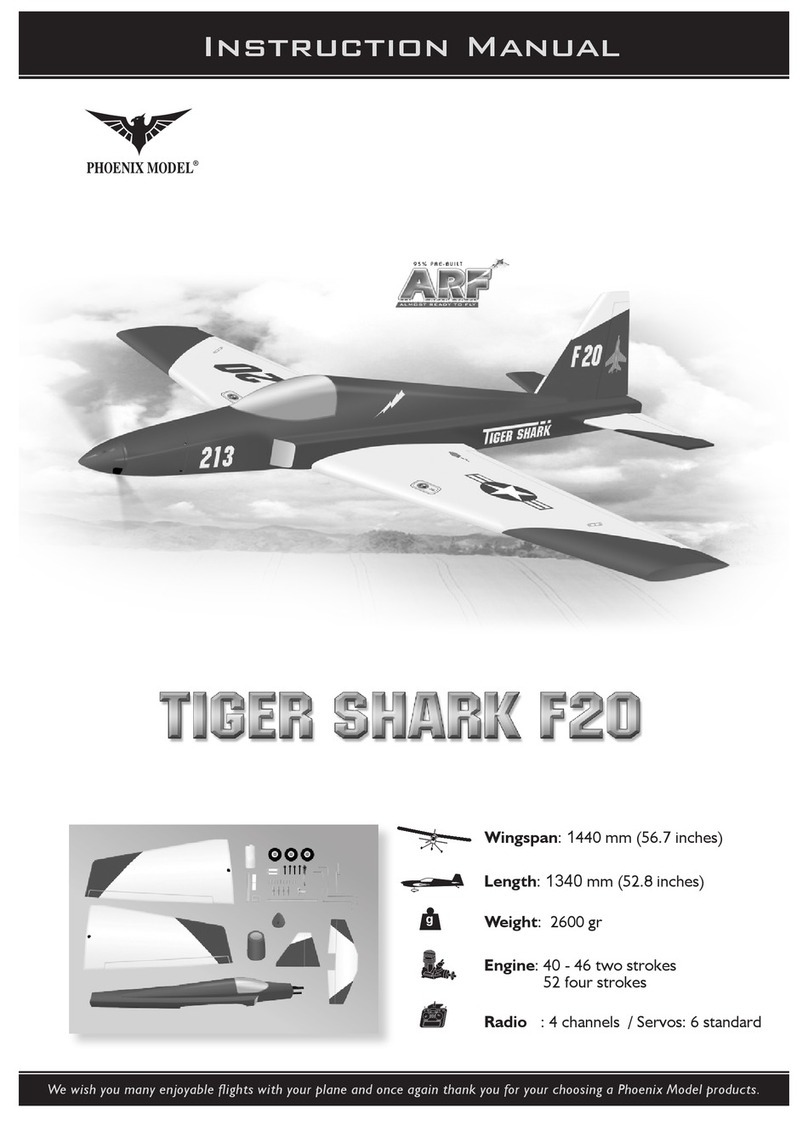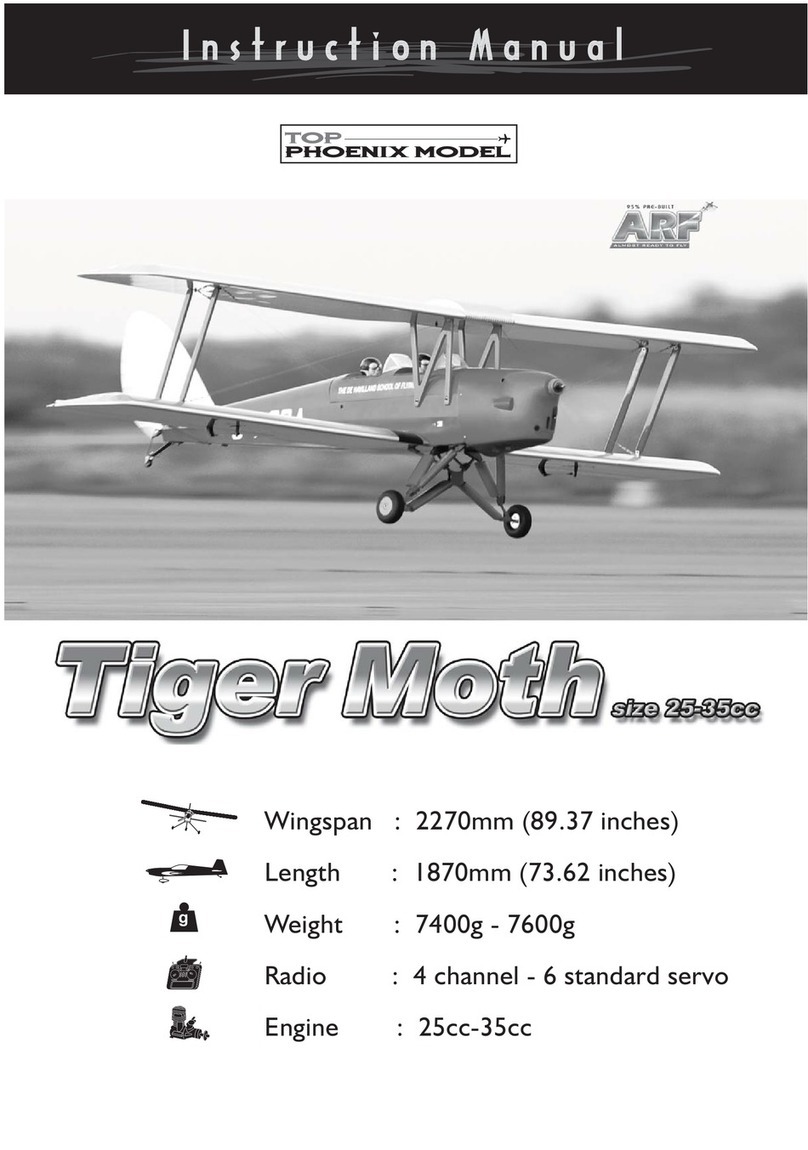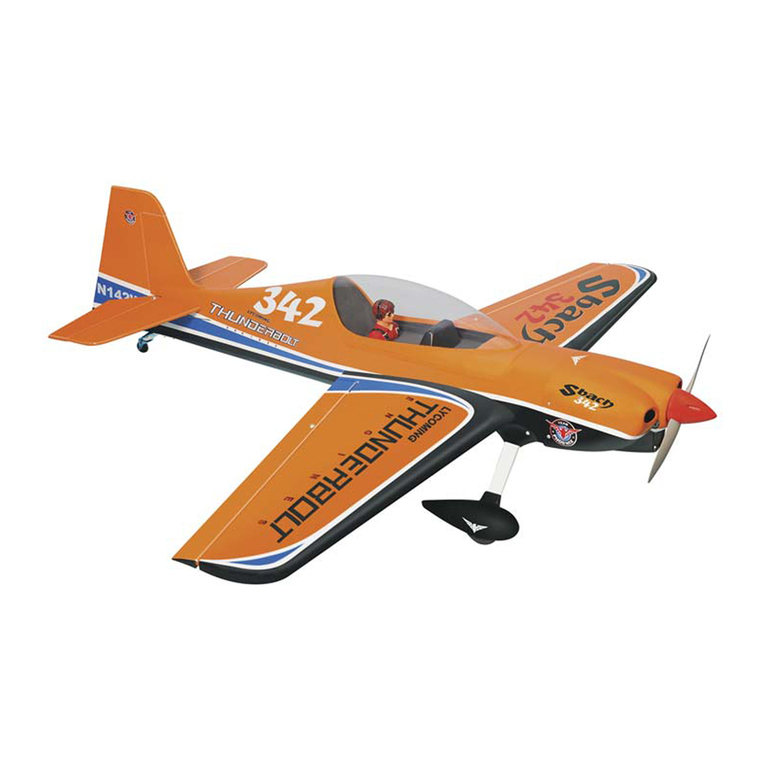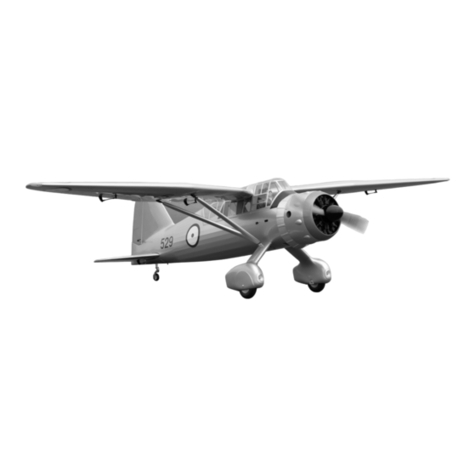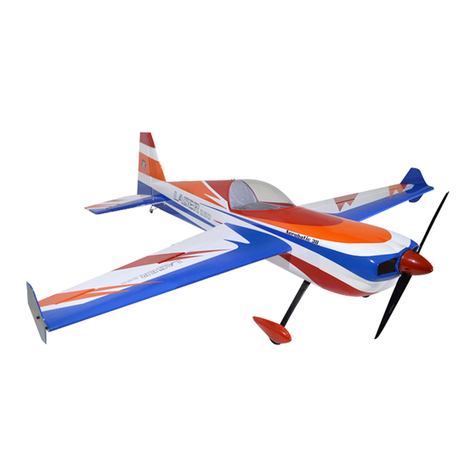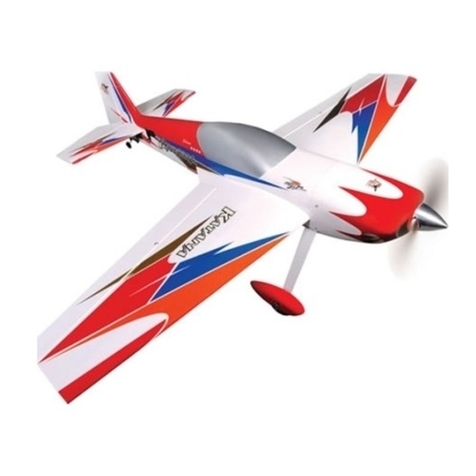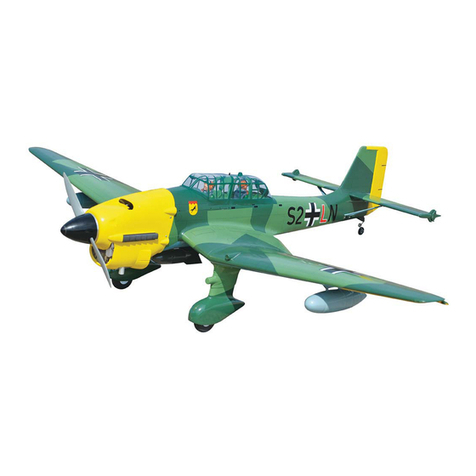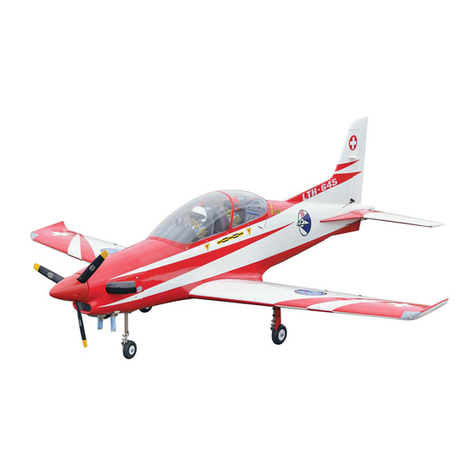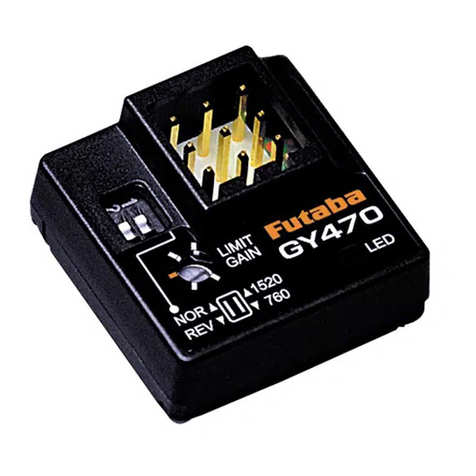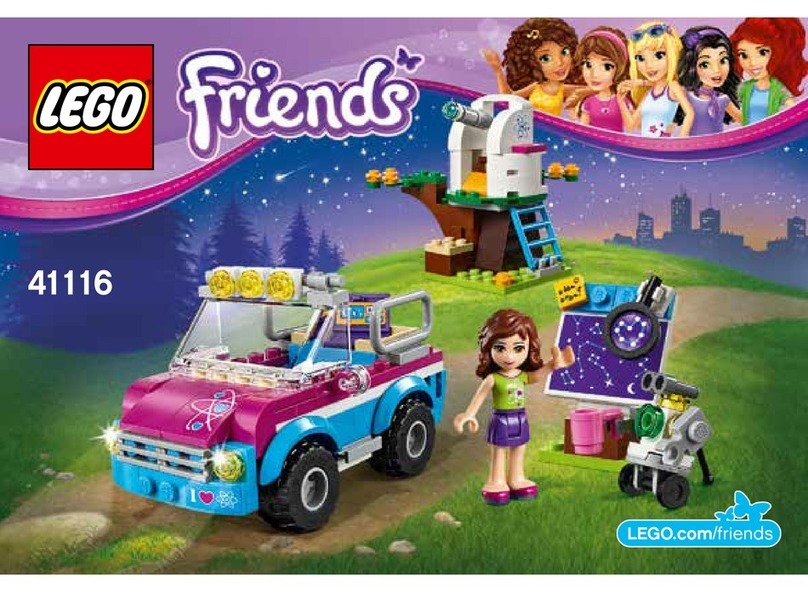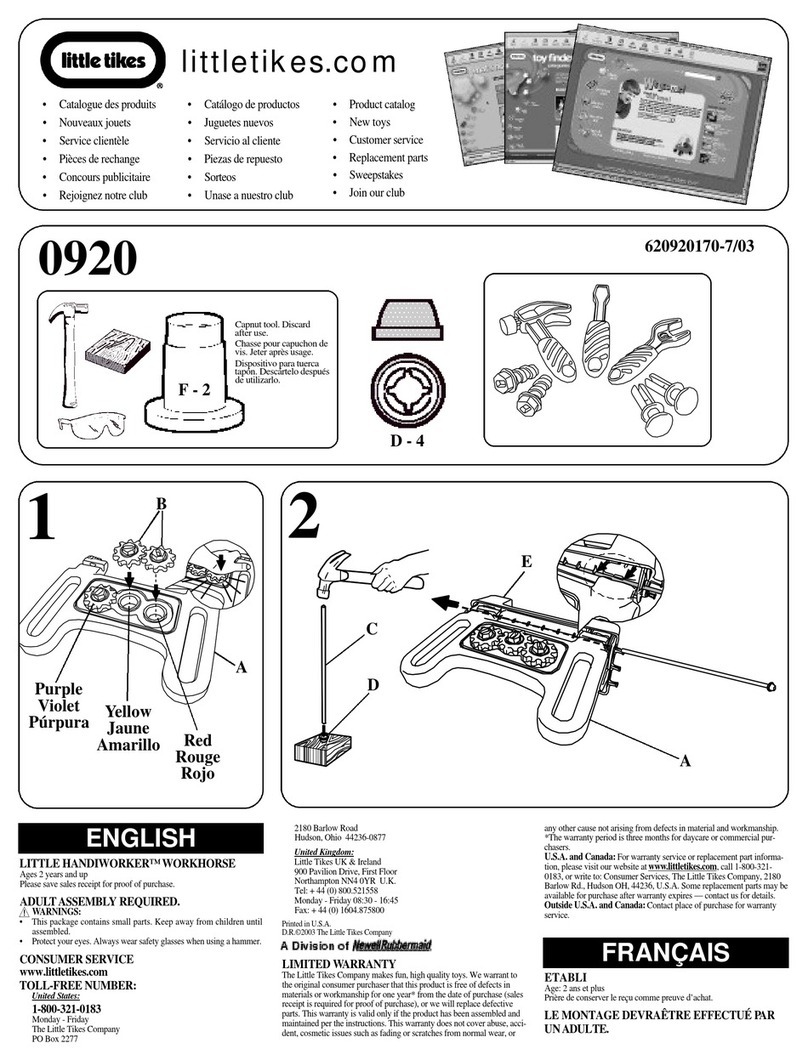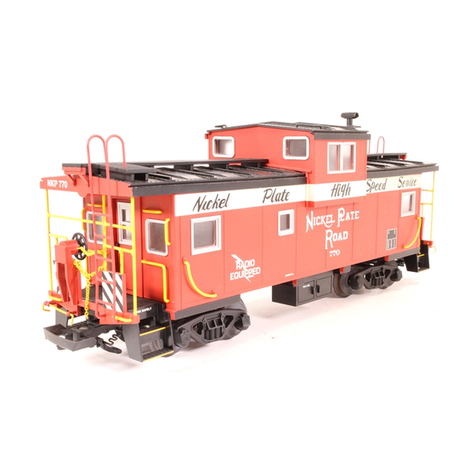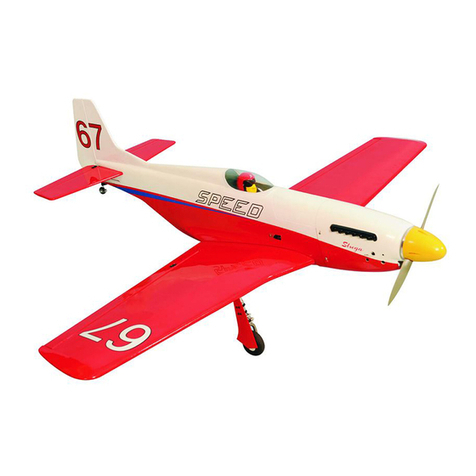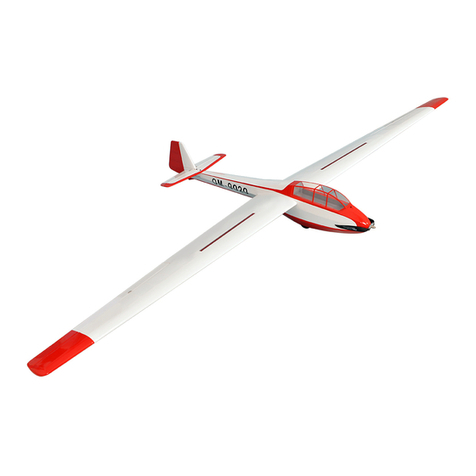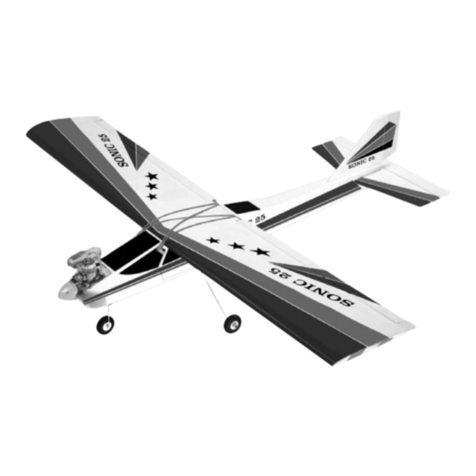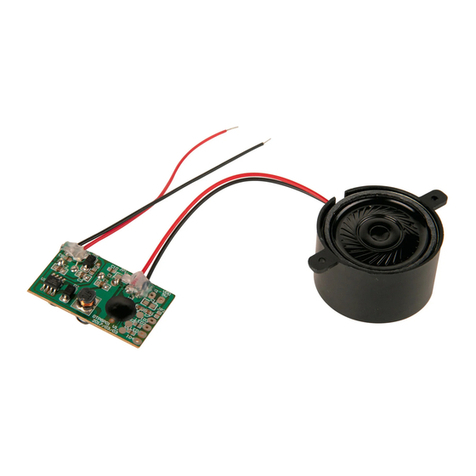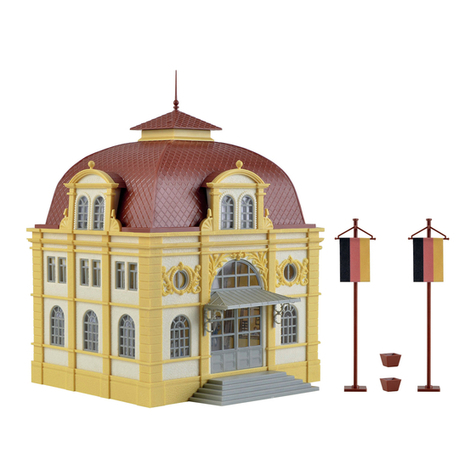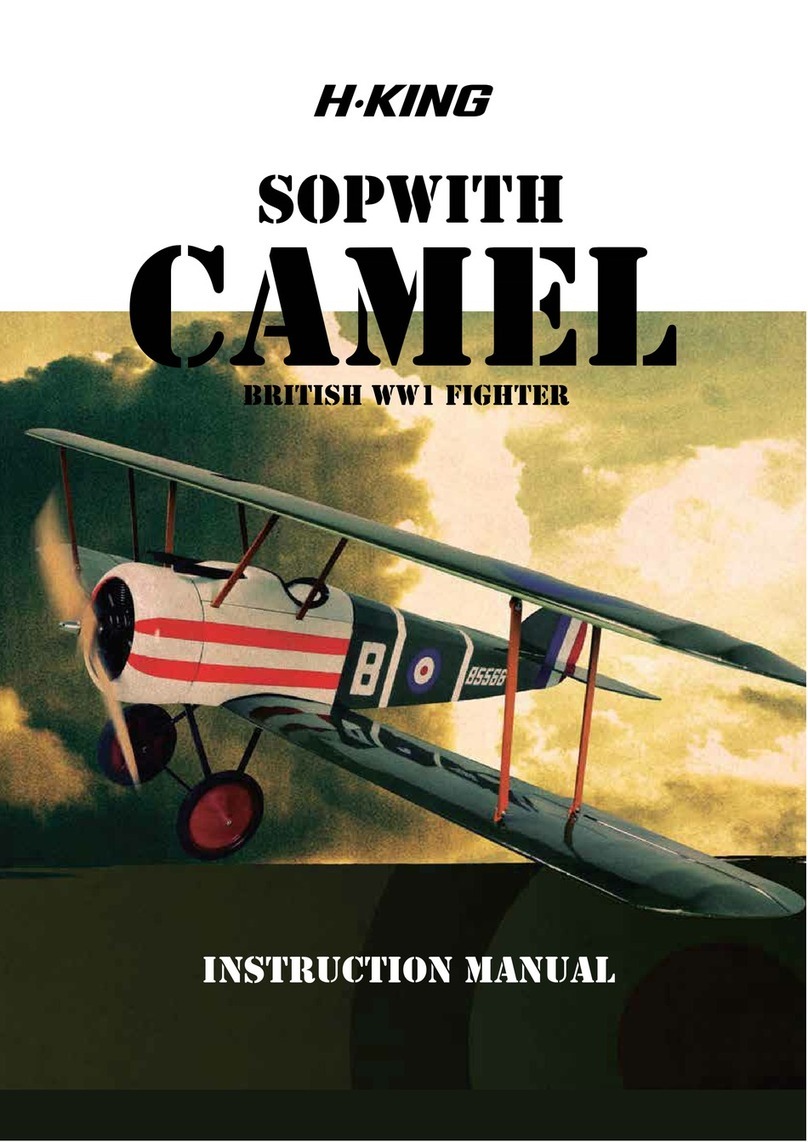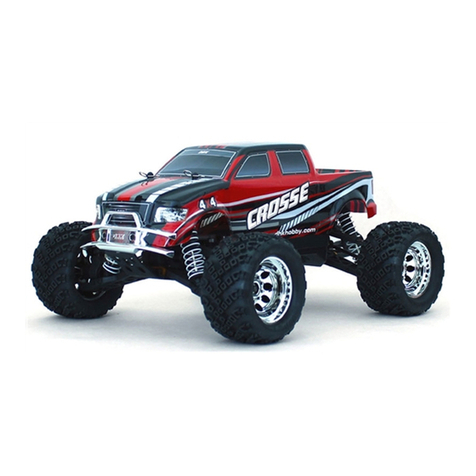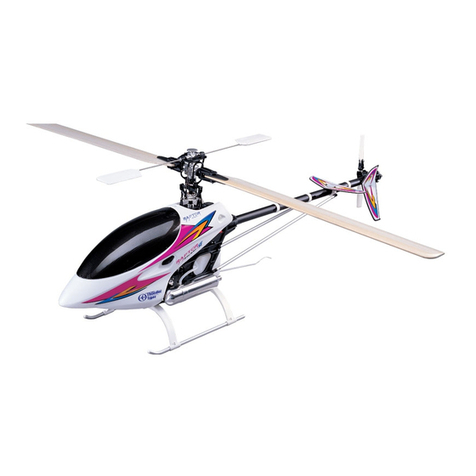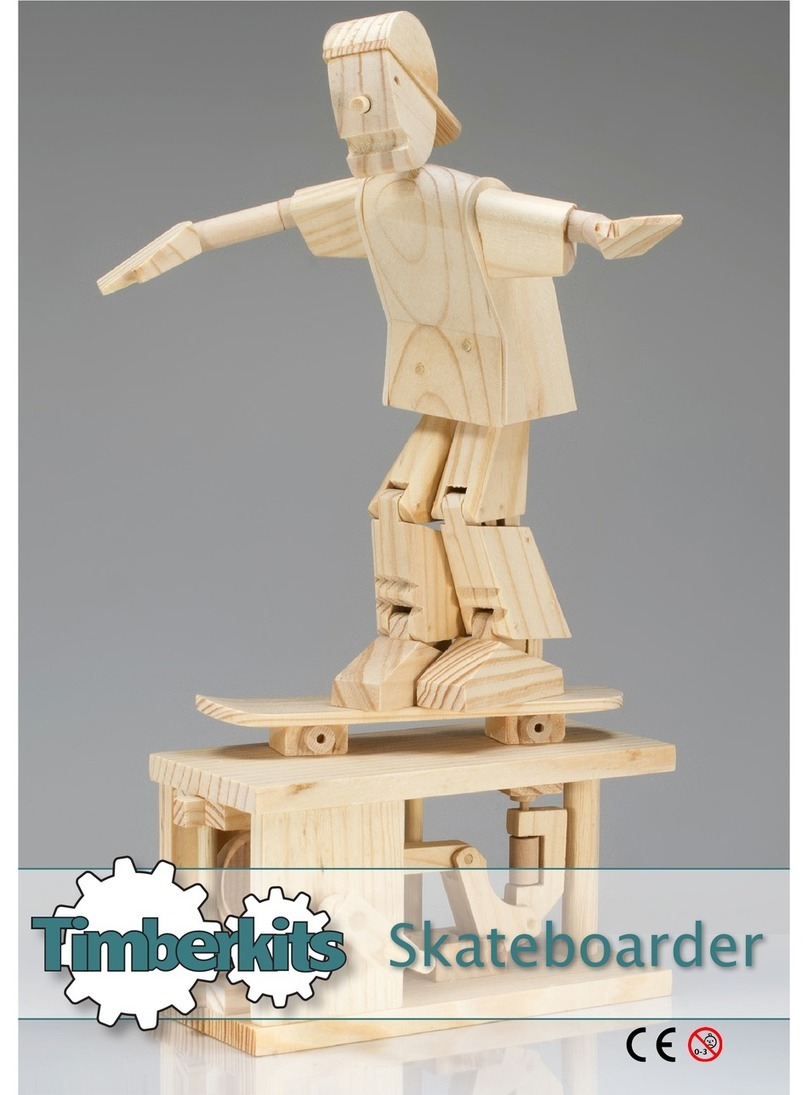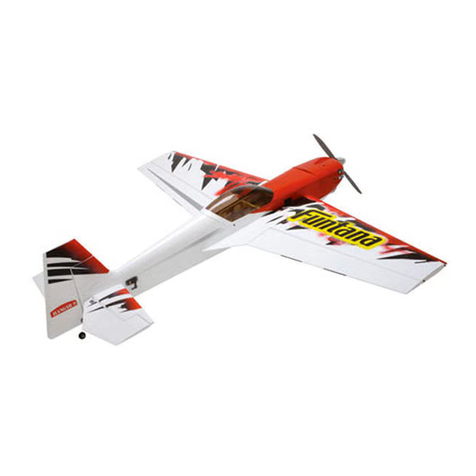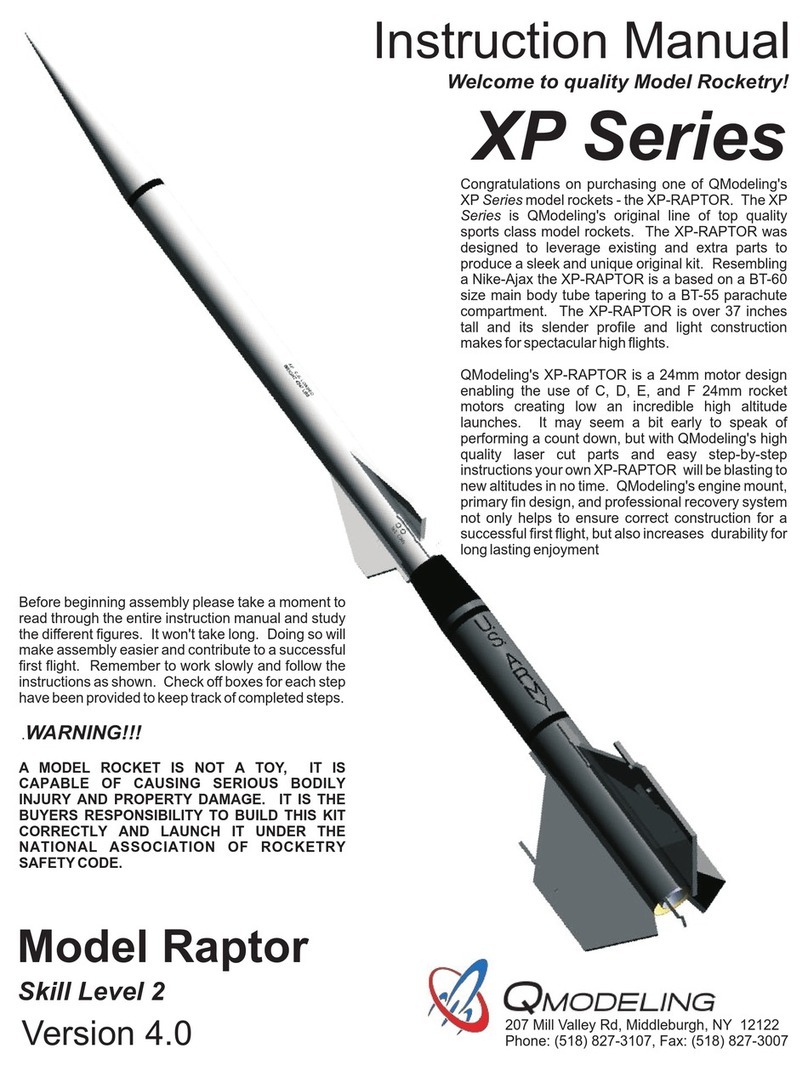KIT CONTENTS: We have organized the parts as they come out of the box for better identification
during assembly. We recommend that you regroup the parts in the same manner. This will ensure you
have all of parts required before you begin assembly.
MAIN GEAR ASSEMBLY
(1) Main gear
(2) 115mm wheel
(8) 4mm x 20mm machine screw
(8) 4mm flat washer
(4) 3mm x 15mm machine screw
(4) 6mm flat washer
(2) Plastic plate
(4) Collar
TAIL GEAR ASSEMBLY
(1) Tail wheel bracket w/ wire
(1) 25mm diameter wheel
(1) Plate Aluminum
(2) 3mm x 12mm wood screws
(2) 3mm x 20mm machine screws
(2) Spring
(2) 3mm flat washers
ELEVATOR CONTROL SYSTEM
(4) Set control horn
(2) Nylon clasp
(2) 3mm x 12mm screws
(2) 6mm flat washer
(2) 3mm nut
(2) 1.7mm x 1300mm metal pushrod
(2) Nylon snap keeper
(8) 4mm x 20mm screws
(8) 8mm flat washer
(8) 4mm flat washer
engine mount
(2) Engine mount
(4) 4mm x 30mm wood screw
(4) 4mm flat washer
(8) 8mm flat washer
(4) 4mm flat washer
(4) 3mm x 30mm machine screw
(8) 4mm nut
FUEL TANK
(1) Nylon fuel Tank
(1) Metal clunk
(1) Pre - assembled stopper w / 3 tube
(2) Zip tie
MISCELLANEOUS ITEMS
(3) Aluminum dihedral
(4) Wing screw
(2) 4mm x 30mm nylon screw
(4) 2.6mm x 10mm wood screw
(1) Plastic plate
(1) Circle plate
(1) Wooden plate
(1) Cowling
(1) Decal
(1) Instruction manual
(16) 3mm x 10mm screw
(4) 3mm nut
RUDDER CONTROL SYSTEM
(2) Set control horn
(4) Metal connector
(2) Aluminum ball
(2) Nylon ball link
(2) 3mm x 12mm screws
(4) Crimp
(2) 3mm nut
(2) M3 clevis
(2) Metal cable
AILERON CONTROL SYSTEM
(8) Set control horn
(8) Aluminum ball
(8) Nylon ball link
(8) 3mm x 12mm screws
(4) 6mm flat washer
(8) 3mm nut
(2) 3mm x 70mm metal pushrod
(2) 3mm x 60mm metal pushrod
(16) 2mm x 10mm screws
THROTTLE CONTROL SYSTEM
(1) M2 Clevise
(1) Silicone tube
(1) 1.7mm x 300mm metal pushrod
(2) Crimp
(1) M3 clevis
(1) Metal cable
(1) Metal connector
(1) Aluminum 2.4mm
KIT CONTENTS
Instruction Manual PA-18 SUPER CUB
1
LA9
I/C FLIGHT WARNINGS
Always operate in open areas, away
from factories, hospitals, schools,
buildings and houses etc. NEVER fly
your aircraft close to people or built
up areas.
THE PROPELLER IS DANGEROUS
Keep fingers, clothing (ties, shirt
sleeves, scarves) or any other loose
objects that could be caught or drawn
in, away from the propeller. Take care
at ALL times.
Keep all onlookers (especially small
children and animals) well back from
the area of operation. This is a flying
aircraft, which will cause serious
injury in case of impact with a person
or animal.
NEVER fly near power lines, aerials
or other dangerous areas including
airports, motorways etc.
NEVER use damaged or deformed
propellers or spinners.
DO NOT dispose of empty fuel
containers on a fire, this can lead to
an explosion.
NEVER fly in wet conditions or on
windy or stormy days.
ALWAYS adjust the engine from
behind the propeller, and do not allow
any part of your body to be in line
with the propeller.
Instruction Manual PA-18 SUPER CUB
17
I/C FLIGHT GUIDELINES
Made in Vietnam
When ready to fly, first extend the
transmitter aerial.
Operate the control sticks on the
transmitter and check that the control
surfaces move freely and in the
CORRECT directions. ALWAYS land the model INTO the
wind, this ensures that the model lands
at the slowest possible speed.
Switch on the transmitter.
Switch off the transmitter.
Check that the transmitter batteries
have adequate power.
Switch off the receiver.
Switch on the receiver. ALWAYS take off into the wind.
Check that the wings are correctly
fitted to the fuselage. If the model does not respond correctly
to the controls, land it as soon as
possible and correct the fault.
Empty the fuel tank after flying, fuel left
in the tank can cause corrosion and
lead to engine problems.
Instruction Manual PA-18 SUPER CUB
!
INSTALLING THE STOPPER ASSEMBLY
1. The stopper has been pre-assembled at the factory.
2. Using a modeling knife, cut one length of silicon
fuel line (the length of silicon fuel line is
calculated by how the weighted clunk should
rest about 8mm away from the rear of the tank
and move freely inside the tank). Connect one
end of the line to the weighted clunk and the
other end to the nylon pick up tube in the
stopper.
3. Carefully bend the second nylon tube up at a
45 degree angle (using a cigarette lighter). This
tube will be the vent tube to the muffler.
4. Carefully bend the third nylon tube down at a
45 degree angle (using a cigarette lighter). This
tube will be vent tube to the fueling valve
When the stopper assembly is installed in the
tank, the top of the vent tube should rest just
below the top surface of the tank. It should not
touch the top of the tank.
8. Feed three lines through the fuel tank
compartment and through the pre-drilled hole in
the firewall. Pull the lines out from behind the
engine, while guiding the fuel tank into place.
Push the fuel tank as far forward as possible,
the front of the tank should just about touch the
back of the firewall. Blow through one of the
lines to ensure the fuel lines have not become
kinked inside the fuel tank compartment. Air
should flow through easily.
5. Test fit the stopper assembly into the tank. It
may be necessary to remove some of the
flashing around the tank opening using a
modeling knife. If flashing is present, make sure
none of it falls into the tank.
6. When satisfied with the alignment of the stopper
assembly tighten the 3mm x 20mm machine
screw until the rubber stopper expands and
seals the tank opening. Do not over tighten the
assembly as this could cause the tank to split.
7. Using a modeling knife, cut 3 lengths of fuel line
150mm long. Connect 2 lines to the 2 vent tubes
and 1 line to the fuel pickup tube in the stopper.
INSTALLING THE ENGINE
This manual, we used the GT 22 OS
57
150mm
58
Machine screw
Instruction Manual PA-18 SUPER CUB
11
54
Instruction Manual PA-18 SUPER CUB
10
5. Thread the metal connector to the link ball.
55
6. Center the rudder servo using the radio and
install the servo arm. Attach the metal clevis to
the rudder servo arm.
56
7. Slide a crimp onto the cable, then pass the cable
through the threaded cable end. Pass the cable
back into the crimp and use crimping pliers to
secure the crimp to the cable.
8. Thread the metal connector to the metal clevis.
9. Attach the clevis to the rudder servo. There
should be light tension on each of the wires
when installed properly.
Note: Remember use thread locking compound
to secure.
120mm
4. If the nose of the plane falls, the plane is nose
heavy. To correct this first move the battery
pack further back in the fuselage. If this is not
possible or does not correct it, stick small
amounts of lead weight on the fuselage under
the horizontal stabilizer. If the tail of the plane
falls, the plane is tail heavy. To correct this,
move the battery and receiver forward or if this
is not possible, stick weight into the firewall.
When balanced correctly, the airplane should
sit level or slightly nose down when you lift it up
with your fingers.
2. Mount the wing to the fuselage. Using a couple
of pieces of masking tape, place them on the
top side of the wing 120mm back from the
leading edge, at the fuselage sides.
3. Turn the airplane upside down. Place your
fingers on the masking tape and carefully lift
the plane .
BALANCING
1. It is critical that your airplane be balanced
correctly. Improper balance will cause your
plane to lose control and crash.
THE CENTER OF GRAVITY IS LOCATED
120mm BACK FROM THE LEADING EDGE
OF THE WING,AT THE FUSELAGE.
IF YOU FLY THIS MODEL BY ELECTRIC, PLEASE
SECURE THE POLY BATTERY AS THESE STEP BELOW.
CONTROL THROWS
1. We highly recommend setting up a plane using
the control throws listed.
2. The control throws should be measured at the
widest point of each control surface.
3. Check to be sure the control surfaces move in
the correct directions.
!
LATERAL BALANCE
After you have balanced a plane on the C.G.
You should laterally balance it. Doing this will
help the airplane track straighter.
1. Turn the airplane upside down. Attach one loop
of heavy string to the engine crankshaft and
one to the tail wheel wire. With the wings level,
carefully lift the airplane by the string. This may
require two people to make it easier.
2. If one side of the wing fall, that side is heavier
than the opposite. Add small amounts of lead
weight to the bottom side of the lighter wing
half's wing tip. Follow this procedure until the
wing stays level when you lift the airplane.
Instruction Manual PA-18 SUPER CUB
15
Instruction Manual PA-18 SUPER CUB
14
open and close the canopy
Glue the light.
Glue the light.
82
Open - Close
81
CA Glue
83
Screw
66
Instruction Manual PA-18 SUPER CUB
13
72
73
Screw
74
75 79
INSTALLING THE HORIZONTAL STRUT
g
Instruction Manual
Instruction Manual PA-18 SUPER CUB
2
TOOLS AND SUPPLIES NEEDED
• Medium C/A glue
• 30 minute epoxy
• 6 minute epoxy
• Hand or electric drill
• Assorted drill bits
• Modeling knife
• Straight edge ruler
SUGGESTION
To avoid scratching your new airplane, do not unwrap
the pieces until they are needed for assembly. Cover
your workbench with an old towel or brown paper,
both to protect the aircraft and to protect the table.
Keep a couple of jars or bowls handy to hold the
small parts after you open the bag.
NOTE:
1. Please trial fit all the parts. Make sure you have
the correct parts and that they fit and are aligned
properly before gluing! This will assure proper
assembly. The PA-18 SUPER CUB size
22cc-33cc is hand made from natural materials,
every plane is unique and minor adjustments
may have to be made. However, you should find
the fit superior and assembly simple.
2. The painted and plastic parts used in this kit are
fuel proof. However, they are not tolerant of many
harsh chemicals including the following: paint
thinner, C/A glue accelerator, C/A glue debonder
and acetone. Do not let these chemicals come in
contact with the colors on the covering and the
plastic parts.
SAFETY PRECAUTION:
• This is not a toy.
• Be sure that no other flyers are using your radio
frequency.
• Do not smoke near fuel.
• Store fuel in a cool, dry place, away from
children and pets.
• Wear safety glasses.
• The glow plug clip must be securely attached to
the glow plug.
• Do not flip the propeller with your fingers.
• Keep loose clothing and wires away from the
propeller.
• Do not start the engine if people are near. Do not
stand in line with the side of the propeller.
• Make engine adjustments from behind the
propeller only. Do not reach around the spinning
propeller.
• 2 bender plier
• Wire cutters
• Masking tape
• Thread lock
• Paper towels
• Rubbing alcohol
Dihedral brace
17
2. Slide the joiner to the horizontal stabilizer.
Instruction Manual PA-18 SUPER CUB
8
18
Dihedral brace
16
Remove the covering
1. Remove the covering from the fuselage.
3. Attach the stabilizer to the fuselage.
INSTALLING THE HORIZONTAL STABILIZER
Glue C.A 22
23
Remove the covering 20
21
2. Slide the joiner to the rudder.
3. Glue a plate wood to the exit hole.
Instruction Manual PA-18 SUPER CUB
6
INSTALLING THE VERTICAL STABILIZER
1. Remove the covering from the bottom of the
rudder.
4. Secure the stabilizer.
19
SERVO INSTALLATION
INSTALLING THE FUSELAGE SERVOS
1. Install the rubber grommets and brass collets
into the elevator, rudder and throttle servos.
Test fit the servos into the servo tray. Trim the
tray if necessary to fit your servos
2. Mount the servos to the tray using the mounting
screws provided with your radio system.
3. Working from inside the fuselage, slide the
threaded end of the pushrod until it reaches the
exit slot. Carefully reach in with a small screw
driver and guide the pushrod out of the exit slot.
INSTALLING THE ELEVATOR PUSHROD
1. Locate the pushrod exit slot on the right side
and left side of the fuselage. It is located
slightly ahead and below the horizontal
stabilizer.
2. Carefully cut away the covering material from
the slot.
39
Elevator servo
Elevator servo
38
Screw
40
Remove the covering
4. Slide a crimp onto the cable, then pass the
cable through the threaded cable end. Pass
the cable back into the crimp and use crimping
pliers to secure the crimp to the cable. Guide
the cable into the fuselage to the position for
the rudder servo.
Cable end
Crimp Aluminum ball
Cable
Metal connector
Plastic ball link
53
52
50
Instruction Manual PA-18 SUPER CUB
9
3. Install and secure the control horn to the rudder
using C.Aglue.
51
48
INSTALLING THE RUDDER SERVO
Install the rudder servo to the fuselage as shown.
INSTALLING THE RUDDER LINKAGES
The rudder is controlled by two metal cables.
Install the rudder linkages and cables as
below.
1. Use a hobby knife to remove the covering from
the openings for the rudder control cables.
2. The rudder has a block wood plate for mounting
the control horn. Two control horn in positioned
on both side rudder (left and right).
49
Remove the covering
Instruction Manual PA-18 SUPER CUB
3
3. Repeat step 1 - step 3 for the second aileron
linkage.
13
2. Install the link ball to the control horn.
INSTALLING THE AILERON LINKAGES
1. The aileron linkages are assembled as shown
below.
INSTALLING THE flap
Repeat these step from installing the aileron for
installing the flap.
12
Instruction Manual PA-18 SUPER CUB
4
Screw
Flat washer
Flat washer
M3 nut
Aluminum link ball
Servo arm
Plastic link ball
15
60mm
22mm 22mm
11
70mm
22mm 22mm
14
Elevator Control
Aileron Control
12mm
12mm
Rudder Control
30mm
30mm
Flap Control
15mm
12mm
12mm
FLIGHT PREPARATION PRE FLIGHT CHECK
1. Completely charge your transmitter and receiver
batteries before your first day of flying.
2. Check every bolt and every glue joint in your
plane to ensure that everything is tight and well
bonded.
3. Double check the balance of the airplane
4. Check the control surface
5. Check the receiver antenna . It should be fully
extended and not coiled up inside the fuselage.
6. Properly balance the propeller.
Aileron 12mm up 12mm down
Elevator 12mm up 12mm down
Rudder 30mm right 30mm left
Flap 15mm down
Low rate:
Instruction Manual PA-18 SUPER CUB
16
44
Instruction Manual PA-18 SUPER CUB
7
10. With the elevator halves and elevator servo
centered, carefully place a mark on the elevator
pushrod wire where it crosses the hole in the
servo arm.
11. Using pliers, carefully make a 90 degree bend
up at the mark made. Cut off the excess wire,
leaving about 8mm beyond the bend.
12. Make the same way for the second elevator.
8. Locate one nylon servo arm, and using wire
cutters, remove all but one of the arms. Using a
2mm drill bit, enlarge the third hole out from the
center to accommodate the elevator pushrod wire.
9. Plug the elevator servo into the receiver and
center the servo. Install the servo arm onto the
servo. The servo arm should be perpendicular
to the servo and point toward the middle of the
fuselage.
41
43
Control horn
Control horn
46
47
45
4. Install the nylon clevis into the two elevator
pushrod.
Make sure 6mm of thread shows inside
the clevis.
5. The control horn should be mounted on the
bottom, left side and right side of the elevator
.
6. Remove the covering from the slot on the
elevator. Insert and secure the control horn in
place using the C.A glue.
42
CA glue
7. Attach nylon clevis to the control horn and
secure it .
Instruction Manual PA-18 SUPER CUB
5
INSTALLING THE THROTTLE SERVO
1. Install the rubber grommets and brass collets
into the elevator, rudder and throttle servos.
Test fit the servos into the servo tray. Trim the
tray if necessary to fit your servos
2. Mount the servos to the tray using the mounting
screws provided with your radio system.
61
60
Screw
Do not secure the tank into place permanently
until after balancing the airplane. You may need
to remove the tank to mount the battery in the
fuel tank compartment.
9. To secure the fuel tank in place, apply a bead of
silicon sealer to the forward area of the tank,
where it exits the fuselage behind the engine
mounting box and to the rear of the tank at the
forward bulkhead.
63
Engine
62
Engine
64
65
Screw
!
MOUNTING THE COWL
1. Measure and mark the locations to be cut out
for engine head clearance, needle valve,
muffler. Remove the cowl and make these cut
outs using a rotary tool with a cutting disc and a
rotary sanding drum attachment.
2. Slide the cowl back into place. Align the front of
the cowl with the crankshaft of the engine. The
front of the cowl should be positioned so the
crankshaft is in the middle of the precut
opening. Hold the cowl firmly in place using
several pieces of masking tape.
3. While holding the cowl firmly in position, drill
four 1,6mm pilot holes through both the cowl
and the side edges of the firewall.
4. Using a 3mm drill bit, enlarge the four holes in
the cowling.
Enlarging the holes through the cowl will prevent
the fiberglass from splitting when the mounting
screws are installed.
5. Slide the cowl back over the engine and secure
it in place using four 3mm x 12mm wood
screws.
Instruction Manual
12
PA-18 SUPER CUB
PREPARATIONS
Remove the tape and separate the ailerons
from the wing and the elevators from the stab.
Use a covering iron with a covering sock on
high heat to tighten the covering if necessary.
Apply pressure over sheeted areas to
thoroughly bond the covering to the wood.
1
3. Place the servo into the servo tray. Center the
servo within the tray and drill 1,6mm pilot holes
through the block of wood for each of the four
mounting screws provided with the servo.
Remove the covering
2
INSTALLING THE AILERON and flap SERVOS
1. Install the rubber grommets and brass eyelets
onto the aileron servo.
2. Using a modeling knife, remove the covering
from over the pre-cut servo arm exit hole on the
aileron servo tray / hatch. This hole will allow
the servo arm to pass through when installing
the aileron pushrods.
36
5
8
7
5. Place the aileron servo tray / hatch into the
servo box on the bottom of the wing and drill
1,6mm pilot holes through the tray and the
servo box for each of the four mounting screws.
Secure the servo tray in place using the
mounting screws provided ( 2mm x 12mm ).
6. Repeat step # 2 - # 5 to install the second
aileron servo in the opposite wing half.
2. Repeat step # 1 - # 2 to install the control horn
on the opposite aileron.
9
10
4. Using the thread as a guide and using masking
tape, tape the servo lead to the end of the
thread: carefully pull the thread out. When you
have pulled the servo lead out, remove the
masking tape and the servo lead from the
thread.
Servo lead
C.A glue
Remove the covering
4
INSTALLING THE CONTROL HORNS
1. One aileron control horn in positioned on each
aileron. It should be mounted on the bottom
side of the aileron.
INSTALLING THE CONTROL HORNS for flap
Repeat step #1 - #2 from installing the control
horn for aileron to install the control horn for
flap.
control
28
5. Connect the spring.
INSTALLING THE TAIL WHEEL
1. The tail wheel set.
INSTALLING THE landing gear
- The tail wheel set.
- Remove the covering.
- Secure the aluminum plate.
- Secure the landing gear.
24
26
27
29
30
Remove the covering
31
Screw
32
Screw
33
Machine screw
35
36
37
34
25
2. Remove the covering.
3. Secure the plate to the rudder.
4. Secure the tail brace to the fuselage.
INSTALLING the wing STRUT:
1. The wing strut.
67
69
70
71
2. Remove the covering.
3. Install the metal strap.
4. Secure the wing strut.
3. Secure the wooden plate.
68
Remove the covering
Collar
76
Remove the covering
Wingspan : 2730mm (107.4 inches)
Length : 1800mm (70.87 inches)
Weight : 8800gr
Engine : 22cc - 33cc
Radio : 6 channel - 8 servo
59
80
C.A Glue
77
C.A Glue
78
Screw
Zip tie 84
Screw
85
86
